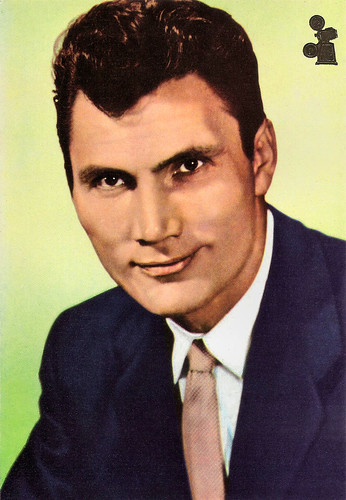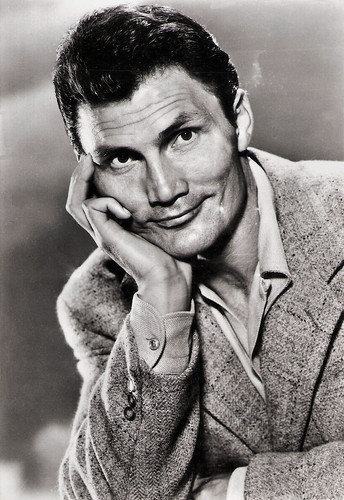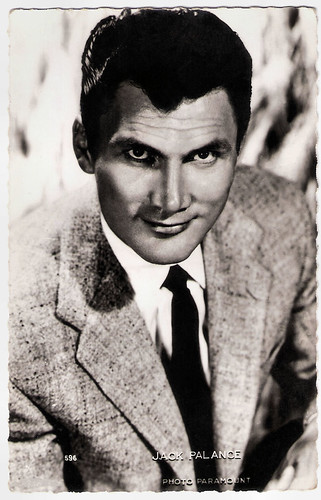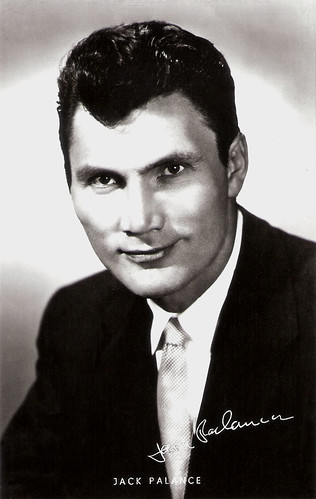Jack Palance (1919-2006) was an American actor and singer, who portrayed some of the most intensely despised villains witnessed in Westerns and melodramas of the 1950s. In the late 1950s, he became an international star, who often played in Spaghetti Westerns and in the Nouvelle Vague classic Le Mépris (1963) with Brigitte Bardot. He was nominated for three Academy Awards for Best Actor in a Supporting Role, winning an Oscar for his grizzled, eccentric role in City Slickers (1991).

Spanish postcard by Postalcolor, Hospitalet (Barcelona), no. 107. Photo: Warner Bros.

Spanish postcard by ANMAVI, no. 29.
Jack Palance was born Vladimir Ivanovich Palahniuk in Lattimer Mines, Pennsylvania, in 1919. He was one of the six children of Ukrainian immigrants, Anna (née Gramiak) and Ivan Palahniuk, an anthracite coal miner. After his father had died of black lung disease, the sensitive, artistic lad worked in coal mines before becoming a professional boxer in the late 1930s. Fighting under the name Jack Brazzo, Palance reportedly compiled a record of 15 consecutive victories with 12 knockouts before losing a close decision to future heavyweight contender Joe Baksi in a Pier-6 brawl.
With the outbreak of World War II, Palance's athletic career ended, and his military career began as a member of the United States Army Air Forces. He was honorably discharged from the United States Army Air Forces in 1944. After the war, he attended Stanford University, leaving one credit shy of graduating to pursue a career in the theatre. During his university years, he worked as a short order cook, waiter, soda jerk, lifeguard at Jones Beach State Park, and photographer's model. His new last name, Palance, was a derivative of his original name. No one could pronounce his last name and it was suggested that he be called Palanski. From that he decided just to use Palance instead.
In 1947, Palance made his Broadway debut in The Big, playing a Russian soldier, directed by Robert Montgomery. His acting break came as Marlon Brando's understudy in A Streetcar Named Desire, and he eventually replaced Brando on stage as Stanley Kowalski. He debuted on television in 1949 and made his screen debut as a gangster in the Film Noir Panic in the Streets (Eliz Kazan, 1950). As a plague carrying fugitive, he stood out among a powerhouse cast including Richard Widmark and Paul Douglas.
The same year he made fine use of his former boxing skills and war experience for the film Halls of Montezuma (Lewis Milestone, 1951) about the United States Marines in World War II. He returned to Broadway for Darkness at Noon (1951), by Sidney Kingsley, which was a minor hit. Palance was second billed in just his third film, playing opposite Joan Crawford in the thriller Sudden Fear (David Miller, 1952). According to Gary Brumburgh at IMDb, Palance found “the right menace and intensity to pretty much steal the proceedings”, and he received an Oscar nomination for Best Supporting Actor.
He was nominated in the same category the following year as well, for his role as the hired gunfighter Jack Wilson in Shane (George Stevens, 1953). Brumburgh again: “arguably his finest villain of the decade, that of creepy, sadistic gunslinger Jack Wilson who becomes Alan Ladd's biggest nightmare (not to mention others) in the classic western Shane (1953). Their climactic showdown alone is text book.“ Shane was a huge hit and Palance was now established as a film name.
He played another villain in Second Chance (Rudolph Maté, 1953) opposite Robert Mitchum and was an Indian in Arrowhead (Charles Marquis Warren, 1953), opposite Charlton Heston. He got a chance to play a heroic role in the thriller Flight to Tangier (Charles Marquis Warren, 1953). Palance played the lead in Man in the Attic (Hugo Freegonese, 1953), a remake of The Lodger (1927), the classic silent film by Alfred Hitchcock. Palance was Attila the Hun in Sign of the Pagan (Douglas Sirk, 1954) with Jeff Chandler, and Simon Magus in the Ancient World epic The Silver Chalice (Victor Saville, 1954) with Paul Newman.
He had the star part in I Died a Thousand Times (Stuart Heisler, 1955), a remake of High Sierra and was cast by Robert Aldrich in two star parts: as a Hollywood star in the Film Noir The Big Knife (1955) based on the play by Clifford Odets; and as a tough WW II soldier in Attack (1956). He was in a Western, The Lonely Man (Henry Levin, 1957), playing the father of Anthony Perkins, and played a double role in House of Numbers (Russell Rouse, 1957). In 1957, Palance won an Emmy Award for best actor for his portrayal of Mountain McClintock in the Playhouse 90 production of Rod Serling's Requiem for a Heavyweight.

French postcard by P.I., no. 596, 1955. Photo: Paramount.
In the following years, Jack Palance became an international star. He was hired by British Warwick Films to play the hero in The Man Inside (John Gilling, 1958). He was reunited with Robert Aldrich and Jeff Chandler on Ten Seconds to Hell (1959) playing a bomb disposal expert, filmed in Germany. He made the drama Flor de Mayo/Beyond All Limits (Roberto Gavaldón, 1959), with Maria Felix, in Mexico, and Austerlitz (Abel Gance, 1960) in France.
Then he did a series of adventure films in Italy: Revak the Rebel/The Barbarians (Rudolph Maté, 1961) with Milly Vitale, Rosmunda e Alboino/Sword of the Conqueror (Carlo Campogalliani, 1961) with Eleonora Rossi-Drago, and I mongoli/The Mongols (Andre DeToth, Leopoldo Savona, 1961) opposite Anita Ekberg.
Next he appeared in the Commedia all'italiana Il giudizio universale/The Last Judgment (Vittorio De Sica, 1961) with Alberto Sordi, and the religious epic Barabbas (Richard Fleischer, 1961), starring Anthony Quinn. Jean-Luc Godard persuaded Palance to take on the role of Hollywood producer Jeremy Prokosch in the nouvelle vague movie Le Mépris/Contempt (1963) with Brigitte Bardot. Although the main dialogue was in French, Palance spoke mostly English.
Palance returned to the US to star in the TV series The Greatest Show on Earth (1963–1964). He played a gangster in Once a Thief (Ralph Thomas, 1965) with Alain Delon. He had a featured role opposite Lee Marvin and Burt Lancaster in the Western adventure The Professionals (Richard Brooks, 1966). He guest starred on The Man from UNCLE and the episodes were released as a film, The Spy in the Green Hat (1967). Palance went to England to do Torture Garden (Freddie Francis, 1967) and did Kill a Dragon (Michael D. Moore, 1968) in Hong Kong.
In 1969, Palance recorded a country music album in Nashville, released on Warner Bros. Records. It featured Palance's self-penned song The Meanest Guy That Ever Lived. His films continued to be international co-productions: They Came to Rob Las Vegas (Antonio Isasi-Isasmendi, 1968), the Zapata Western Il mercenario/The Mercenary (Sergio Corbucci, 1968) with Franco Nero, The Desperados (Henry Levin, 1969), and Justine ovvero le disavventure della virtù/Marquis de Sade: Justine (Jésus Franco, 1969), starring Klaus Kinski.
Palance had an excellent part in the Hollywood blockbuster Che! (Richard Fleischer, 1969) playing Fidel Castro opposite Omar Sharif in the title role but the film flopped. Palance went back to action films and Westerns like the Macaroni-War film La legione dei dannati/Battle of the Commandos (Umberto Lenzi, 1970), with Curd Jürgens, and the Zapata Western Companeros (Sergio Corbucci, 1970) with Franco Nero and Tomás Milián.
He had another good role in Monte Walsh (William A. Fraker, 1970), from the author of Shane, opposite Lee Marvin, but the film was a box office disappointment. So too was The Horsemen (John Frankenheimer, 1971) with Omar Sharif. Palance supported Bud Spencer in Si può fare... amigo/It Can Be Done Amigo (Maurizio Lucidi, 1972) and Charles Bronson in Chato's Land (Michael Winner, 1972) and had the lead in the Spaghetti Western Tedeum/Sting of the West (Enzo G. Castellari, 1972).
He returned to Hollywood for Oklahoma Crude (Stanley Kramer, 1973) with Faye Dunaway, and then went to England to star in Craze (Freddie Francis, 1974) opposite Diana Dors.
In the late 1970s Palance was mostly based in Italy. He supported Ursula Andress and Giuliano Gemma in Africa Express (Michele Lupo, 1976), Lee Van Cleef in Diamante Lobo/God's Gun (Gianfranco Parolini, 1976), and Thomas Milian in Squadra antiscippo/The Cop in Blue Jeans (Bruno Corbucci, 1976).
Palance was in the exploitation film Eva Nera/Black Cobra Woman (Joe D’Amato, 1976) with Laura Gemser. He travelled to Canada to make the virtual reality film Welcome to Blood City (Peter Sasdy, 1977) and the US for the slasher film Alone in the Dark (Jack Sholder, 1982).

French postcard by Korès 'Carboplane', no. 328.

German postcard by Netter's Verlag, Berlin.
In 1982, Jack Palance began hosting a television revival of Ripley's Believe It or Not!. The weekly series ran from 1982 to 1986 on the American ABC network. Palance had never been out of work since his career began. But his success on Ripley's Believe It or Not! and the international box-office hit of the German film Bagdad Cafe (Percy Adlon, 1987) resulted in a demand for his services in big budget Hollywood films.
He made memorable appearances as villains in Young Guns (Christopher Cain, 1988), Tango & Cash (Andrei Konchalovsky, 1989) and Batman (Tim Burton, 1989) starring Michael Keaton as Bruce Wayne/Batman and Jack Nicholson as the Joker.
In 1992, four decades after his film debut, Palance won an Academy Award for Best Supporting Actor for his performance as cowboy Curly Washburn in the comedy City Slickers (Ron Underwood, 1991). Stepping onstage to accept the award, the 6' 4" (1.93 m) actor looked down at 5' 7" (1.70 m) Oscar host Billy Crystal (also his co-star in the film), and joked, mimicking one of his lines from the film, "Billy Crystal... I crap bigger than him." He then dropped to the floor and demonstrated his ability, at age 73, to perform one-handed push-ups.
In 1993, during the opening of the Oscars, a spoof of that Oscar highlight featured Palance appearing to drag in an enormous Academy Award statuette with Crystal again hosting, riding on the rear end of it. Halfway across the stage, Palance dropped to the ground as if exhausted, but then performed several one-armed push-ups before regaining his feet and dragging the giant Oscar the rest of the way across the stage.
His later films include Cyborg 2 (Michael Schroeder, 1993) with Angelina Jolie, Cops & Robbersons (Michael Ritchie, 1994) with Chevy Chase, and City Slickers II: The Legend of Curly's Gold (Paul Weiland, 1994).
In 2003, he narrated the documentary Between Hitler and Stalin: Ukraine in World War II (Slavko Nowytski, 2003). In 2004, Palance, at the time chairman of the Hollywood Trident Foundation, walked out of a Russian Film Festival in Hollywood. After being introduced, Palance said, "I feel like I walked into the wrong room by mistake. I think that Russian film is interesting, but I have nothing to do with Russia or Russian film. My parents were born in Ukraine: I'm Ukrainian. I'm not Russian. So, excuse me, but I don't belong here."
Palance was awarded the title of ‘People's Artist’ by Vladimir Putin, president of Russia, but Palance refused the title. His final performance was in the TV film Back When We Were Grownups (Ron Underwood, 2004), opposite Blythe Danner.
Jack Palance was married to his first wife Virginia Baker from 1949 to 1968. They had three children: Holly (1950), Brooke (1952), and Cody (1955–1998). On New Year's Day 2003, Baker was struck and killed by a car in Los Angeles. Palance's daughter Brooke married Michael Wilding, son of Michael Wilding Sr. and Elizabeth Taylor; they have three children. Cody Palance, an actor himself, appeared alongside his father in the film Young Guns. In 1987, Palance married his second wife Elaine Rogers.
In 2006, Jack Palance died of a sudden stroke at his daughter Holly's home in Montecito, California. He was 87.
Trailer Attack (1956). Source: Movieclips Classic Trailers (YouTube).
Trailer City Slickers (1991). Source: Trailer Chan (YouTube).
Sources: Gary Brumburgh (IMDb), Wikipedia, and IMDb.

Spanish postcard by Postalcolor, Hospitalet (Barcelona), no. 107. Photo: Warner Bros.

Spanish postcard by ANMAVI, no. 29.
Alan Ladd's biggest nightmare
Jack Palance was born Vladimir Ivanovich Palahniuk in Lattimer Mines, Pennsylvania, in 1919. He was one of the six children of Ukrainian immigrants, Anna (née Gramiak) and Ivan Palahniuk, an anthracite coal miner. After his father had died of black lung disease, the sensitive, artistic lad worked in coal mines before becoming a professional boxer in the late 1930s. Fighting under the name Jack Brazzo, Palance reportedly compiled a record of 15 consecutive victories with 12 knockouts before losing a close decision to future heavyweight contender Joe Baksi in a Pier-6 brawl.
With the outbreak of World War II, Palance's athletic career ended, and his military career began as a member of the United States Army Air Forces. He was honorably discharged from the United States Army Air Forces in 1944. After the war, he attended Stanford University, leaving one credit shy of graduating to pursue a career in the theatre. During his university years, he worked as a short order cook, waiter, soda jerk, lifeguard at Jones Beach State Park, and photographer's model. His new last name, Palance, was a derivative of his original name. No one could pronounce his last name and it was suggested that he be called Palanski. From that he decided just to use Palance instead.
In 1947, Palance made his Broadway debut in The Big, playing a Russian soldier, directed by Robert Montgomery. His acting break came as Marlon Brando's understudy in A Streetcar Named Desire, and he eventually replaced Brando on stage as Stanley Kowalski. He debuted on television in 1949 and made his screen debut as a gangster in the Film Noir Panic in the Streets (Eliz Kazan, 1950). As a plague carrying fugitive, he stood out among a powerhouse cast including Richard Widmark and Paul Douglas.
The same year he made fine use of his former boxing skills and war experience for the film Halls of Montezuma (Lewis Milestone, 1951) about the United States Marines in World War II. He returned to Broadway for Darkness at Noon (1951), by Sidney Kingsley, which was a minor hit. Palance was second billed in just his third film, playing opposite Joan Crawford in the thriller Sudden Fear (David Miller, 1952). According to Gary Brumburgh at IMDb, Palance found “the right menace and intensity to pretty much steal the proceedings”, and he received an Oscar nomination for Best Supporting Actor.
He was nominated in the same category the following year as well, for his role as the hired gunfighter Jack Wilson in Shane (George Stevens, 1953). Brumburgh again: “arguably his finest villain of the decade, that of creepy, sadistic gunslinger Jack Wilson who becomes Alan Ladd's biggest nightmare (not to mention others) in the classic western Shane (1953). Their climactic showdown alone is text book.“ Shane was a huge hit and Palance was now established as a film name.
He played another villain in Second Chance (Rudolph Maté, 1953) opposite Robert Mitchum and was an Indian in Arrowhead (Charles Marquis Warren, 1953), opposite Charlton Heston. He got a chance to play a heroic role in the thriller Flight to Tangier (Charles Marquis Warren, 1953). Palance played the lead in Man in the Attic (Hugo Freegonese, 1953), a remake of The Lodger (1927), the classic silent film by Alfred Hitchcock. Palance was Attila the Hun in Sign of the Pagan (Douglas Sirk, 1954) with Jeff Chandler, and Simon Magus in the Ancient World epic The Silver Chalice (Victor Saville, 1954) with Paul Newman.
He had the star part in I Died a Thousand Times (Stuart Heisler, 1955), a remake of High Sierra and was cast by Robert Aldrich in two star parts: as a Hollywood star in the Film Noir The Big Knife (1955) based on the play by Clifford Odets; and as a tough WW II soldier in Attack (1956). He was in a Western, The Lonely Man (Henry Levin, 1957), playing the father of Anthony Perkins, and played a double role in House of Numbers (Russell Rouse, 1957). In 1957, Palance won an Emmy Award for best actor for his portrayal of Mountain McClintock in the Playhouse 90 production of Rod Serling's Requiem for a Heavyweight.

French postcard by P.I., no. 596, 1955. Photo: Paramount.
The Meanest Guy That Ever Lived
In the following years, Jack Palance became an international star. He was hired by British Warwick Films to play the hero in The Man Inside (John Gilling, 1958). He was reunited with Robert Aldrich and Jeff Chandler on Ten Seconds to Hell (1959) playing a bomb disposal expert, filmed in Germany. He made the drama Flor de Mayo/Beyond All Limits (Roberto Gavaldón, 1959), with Maria Felix, in Mexico, and Austerlitz (Abel Gance, 1960) in France.
Then he did a series of adventure films in Italy: Revak the Rebel/The Barbarians (Rudolph Maté, 1961) with Milly Vitale, Rosmunda e Alboino/Sword of the Conqueror (Carlo Campogalliani, 1961) with Eleonora Rossi-Drago, and I mongoli/The Mongols (Andre DeToth, Leopoldo Savona, 1961) opposite Anita Ekberg.
Next he appeared in the Commedia all'italiana Il giudizio universale/The Last Judgment (Vittorio De Sica, 1961) with Alberto Sordi, and the religious epic Barabbas (Richard Fleischer, 1961), starring Anthony Quinn. Jean-Luc Godard persuaded Palance to take on the role of Hollywood producer Jeremy Prokosch in the nouvelle vague movie Le Mépris/Contempt (1963) with Brigitte Bardot. Although the main dialogue was in French, Palance spoke mostly English.
Palance returned to the US to star in the TV series The Greatest Show on Earth (1963–1964). He played a gangster in Once a Thief (Ralph Thomas, 1965) with Alain Delon. He had a featured role opposite Lee Marvin and Burt Lancaster in the Western adventure The Professionals (Richard Brooks, 1966). He guest starred on The Man from UNCLE and the episodes were released as a film, The Spy in the Green Hat (1967). Palance went to England to do Torture Garden (Freddie Francis, 1967) and did Kill a Dragon (Michael D. Moore, 1968) in Hong Kong.
In 1969, Palance recorded a country music album in Nashville, released on Warner Bros. Records. It featured Palance's self-penned song The Meanest Guy That Ever Lived. His films continued to be international co-productions: They Came to Rob Las Vegas (Antonio Isasi-Isasmendi, 1968), the Zapata Western Il mercenario/The Mercenary (Sergio Corbucci, 1968) with Franco Nero, The Desperados (Henry Levin, 1969), and Justine ovvero le disavventure della virtù/Marquis de Sade: Justine (Jésus Franco, 1969), starring Klaus Kinski.
Palance had an excellent part in the Hollywood blockbuster Che! (Richard Fleischer, 1969) playing Fidel Castro opposite Omar Sharif in the title role but the film flopped. Palance went back to action films and Westerns like the Macaroni-War film La legione dei dannati/Battle of the Commandos (Umberto Lenzi, 1970), with Curd Jürgens, and the Zapata Western Companeros (Sergio Corbucci, 1970) with Franco Nero and Tomás Milián.
He had another good role in Monte Walsh (William A. Fraker, 1970), from the author of Shane, opposite Lee Marvin, but the film was a box office disappointment. So too was The Horsemen (John Frankenheimer, 1971) with Omar Sharif. Palance supported Bud Spencer in Si può fare... amigo/It Can Be Done Amigo (Maurizio Lucidi, 1972) and Charles Bronson in Chato's Land (Michael Winner, 1972) and had the lead in the Spaghetti Western Tedeum/Sting of the West (Enzo G. Castellari, 1972).
He returned to Hollywood for Oklahoma Crude (Stanley Kramer, 1973) with Faye Dunaway, and then went to England to star in Craze (Freddie Francis, 1974) opposite Diana Dors.
In the late 1970s Palance was mostly based in Italy. He supported Ursula Andress and Giuliano Gemma in Africa Express (Michele Lupo, 1976), Lee Van Cleef in Diamante Lobo/God's Gun (Gianfranco Parolini, 1976), and Thomas Milian in Squadra antiscippo/The Cop in Blue Jeans (Bruno Corbucci, 1976).
Palance was in the exploitation film Eva Nera/Black Cobra Woman (Joe D’Amato, 1976) with Laura Gemser. He travelled to Canada to make the virtual reality film Welcome to Blood City (Peter Sasdy, 1977) and the US for the slasher film Alone in the Dark (Jack Sholder, 1982).

French postcard by Korès 'Carboplane', no. 328.

German postcard by Netter's Verlag, Berlin.
Billy Crystal... I crap bigger than him
In 1982, Jack Palance began hosting a television revival of Ripley's Believe It or Not!. The weekly series ran from 1982 to 1986 on the American ABC network. Palance had never been out of work since his career began. But his success on Ripley's Believe It or Not! and the international box-office hit of the German film Bagdad Cafe (Percy Adlon, 1987) resulted in a demand for his services in big budget Hollywood films.
He made memorable appearances as villains in Young Guns (Christopher Cain, 1988), Tango & Cash (Andrei Konchalovsky, 1989) and Batman (Tim Burton, 1989) starring Michael Keaton as Bruce Wayne/Batman and Jack Nicholson as the Joker.
In 1992, four decades after his film debut, Palance won an Academy Award for Best Supporting Actor for his performance as cowboy Curly Washburn in the comedy City Slickers (Ron Underwood, 1991). Stepping onstage to accept the award, the 6' 4" (1.93 m) actor looked down at 5' 7" (1.70 m) Oscar host Billy Crystal (also his co-star in the film), and joked, mimicking one of his lines from the film, "Billy Crystal... I crap bigger than him." He then dropped to the floor and demonstrated his ability, at age 73, to perform one-handed push-ups.
In 1993, during the opening of the Oscars, a spoof of that Oscar highlight featured Palance appearing to drag in an enormous Academy Award statuette with Crystal again hosting, riding on the rear end of it. Halfway across the stage, Palance dropped to the ground as if exhausted, but then performed several one-armed push-ups before regaining his feet and dragging the giant Oscar the rest of the way across the stage.
His later films include Cyborg 2 (Michael Schroeder, 1993) with Angelina Jolie, Cops & Robbersons (Michael Ritchie, 1994) with Chevy Chase, and City Slickers II: The Legend of Curly's Gold (Paul Weiland, 1994).
In 2003, he narrated the documentary Between Hitler and Stalin: Ukraine in World War II (Slavko Nowytski, 2003). In 2004, Palance, at the time chairman of the Hollywood Trident Foundation, walked out of a Russian Film Festival in Hollywood. After being introduced, Palance said, "I feel like I walked into the wrong room by mistake. I think that Russian film is interesting, but I have nothing to do with Russia or Russian film. My parents were born in Ukraine: I'm Ukrainian. I'm not Russian. So, excuse me, but I don't belong here."
Palance was awarded the title of ‘People's Artist’ by Vladimir Putin, president of Russia, but Palance refused the title. His final performance was in the TV film Back When We Were Grownups (Ron Underwood, 2004), opposite Blythe Danner.
Jack Palance was married to his first wife Virginia Baker from 1949 to 1968. They had three children: Holly (1950), Brooke (1952), and Cody (1955–1998). On New Year's Day 2003, Baker was struck and killed by a car in Los Angeles. Palance's daughter Brooke married Michael Wilding, son of Michael Wilding Sr. and Elizabeth Taylor; they have three children. Cody Palance, an actor himself, appeared alongside his father in the film Young Guns. In 1987, Palance married his second wife Elaine Rogers.
In 2006, Jack Palance died of a sudden stroke at his daughter Holly's home in Montecito, California. He was 87.
Trailer Attack (1956). Source: Movieclips Classic Trailers (YouTube).
Trailer City Slickers (1991). Source: Trailer Chan (YouTube).
Sources: Gary Brumburgh (IMDb), Wikipedia, and IMDb.
No comments:
Post a Comment